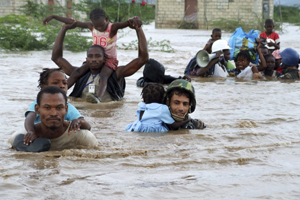 Even though the movement of people as a response to changes in the environment is not a new phenomenon, this issue has risen on the international agenda as a result of the growing awareness of the reality of climate change and its possible implications. Climate change is predicted to increase climate variability and lead to greater intensity and frequency of extreme weather events. With the number of extreme weather events doubling over the past 20 years from 200 to more than 400 a year, some of these effects are already felt. More than 20 million people were displaced by sudden-onset climate related disasters in 2008 alone (OCHA/IDMC 2009) (http://publications.iom.int/bookstore/free/migration_and_environment.pdf). Moreover, gradual changes in the environment are expected to affect even more people and have an even greater impact on the movement of people in the coming years.
Even though the movement of people as a response to changes in the environment is not a new phenomenon, this issue has risen on the international agenda as a result of the growing awareness of the reality of climate change and its possible implications. Climate change is predicted to increase climate variability and lead to greater intensity and frequency of extreme weather events. With the number of extreme weather events doubling over the past 20 years from 200 to more than 400 a year, some of these effects are already felt. More than 20 million people were displaced by sudden-onset climate related disasters in 2008 alone (OCHA/IDMC 2009) (http://publications.iom.int/bookstore/free/migration_and_environment.pdf). Moreover, gradual changes in the environment are expected to affect even more people and have an even greater impact on the movement of people in the coming years.
The migration, environment and climate change nexus is a complex one. Environmental changes can occur gradually (i.e. desertification, erosion, rising sea levels), intensifying existing vulnerabilities – but still providing people with adequate opportunities to plan their migration. Other changes occur suddenly (i.e. storms, earthquakes, floods) and result in haphazard displacement. In the case of gradual environmental changes, it can be difficult to differentiate the role of climate change or environmental factors more generally as a primary driver for migration, as in most instances it is a combination of factors (political, economic and social) that leads to the decision to move.
The complexity of the interrelations between migration and environmental/climate change results in manifold challenges at the policy-making level. Most population movements induced by environmental changes are taking place within state boundaries, grappling with internal displacement phenomena. At the international level, transnational migration resulting from climate change poses the challenge of ensuring international recognition and protection mechanisms for this conceptually “new” category of migrants. This needs to be complemented by longer-term forward-looking policies, including disaster risk reduction and climate change adaptation. Within the context of the
United Nations Framework Convention on Climate Change the development of adaptation strategies, such as the National Adaptation Programmes of Actions (NAPA), has been bolstered. Nevertheless, the need for integrating migration into these strategies persists.
With a view to presenting a nuanced picture of the interrelations between environmental degradation (exacerbated by climate change), migratory decisions and development, and to raise awareness of the international legal instruments and policy tools that exist to address the challenges posed by disaster displacement and environmentally driven migration, UNITAR, together with the International Organization for Migration (IOM), the United Nations Population Fund (UNFPA) and the MacArthur Foundation is organizing a one-day Seminar on “
Environmentally Induced Migration and Climate Change” as part of the Migration and Development Series on 20 April 2010.

 Even though the movement of people as a response to changes in the environment is not a new phenomenon, this issue has risen on the international agenda as a result of the growing awareness of the reality of climate change and its possible implications. Climate change is predicted to increase climate variability and lead to greater intensity and frequency of extreme weather events. With the number of extreme weather events doubling over the past 20 years from 200 to more than 400 a year, some of these effects are already felt. More than 20 million people were displaced by sudden-onset climate related disasters in 2008 alone (OCHA/IDMC 2009) (http://publications.iom.int/bookstore/free/migration_and_environment.pdf). Moreover, gradual changes in the environment are expected to affect even more people and have an even greater impact on the movement of people in the coming years.
Even though the movement of people as a response to changes in the environment is not a new phenomenon, this issue has risen on the international agenda as a result of the growing awareness of the reality of climate change and its possible implications. Climate change is predicted to increase climate variability and lead to greater intensity and frequency of extreme weather events. With the number of extreme weather events doubling over the past 20 years from 200 to more than 400 a year, some of these effects are already felt. More than 20 million people were displaced by sudden-onset climate related disasters in 2008 alone (OCHA/IDMC 2009) (http://publications.iom.int/bookstore/free/migration_and_environment.pdf). Moreover, gradual changes in the environment are expected to affect even more people and have an even greater impact on the movement of people in the coming years. 
